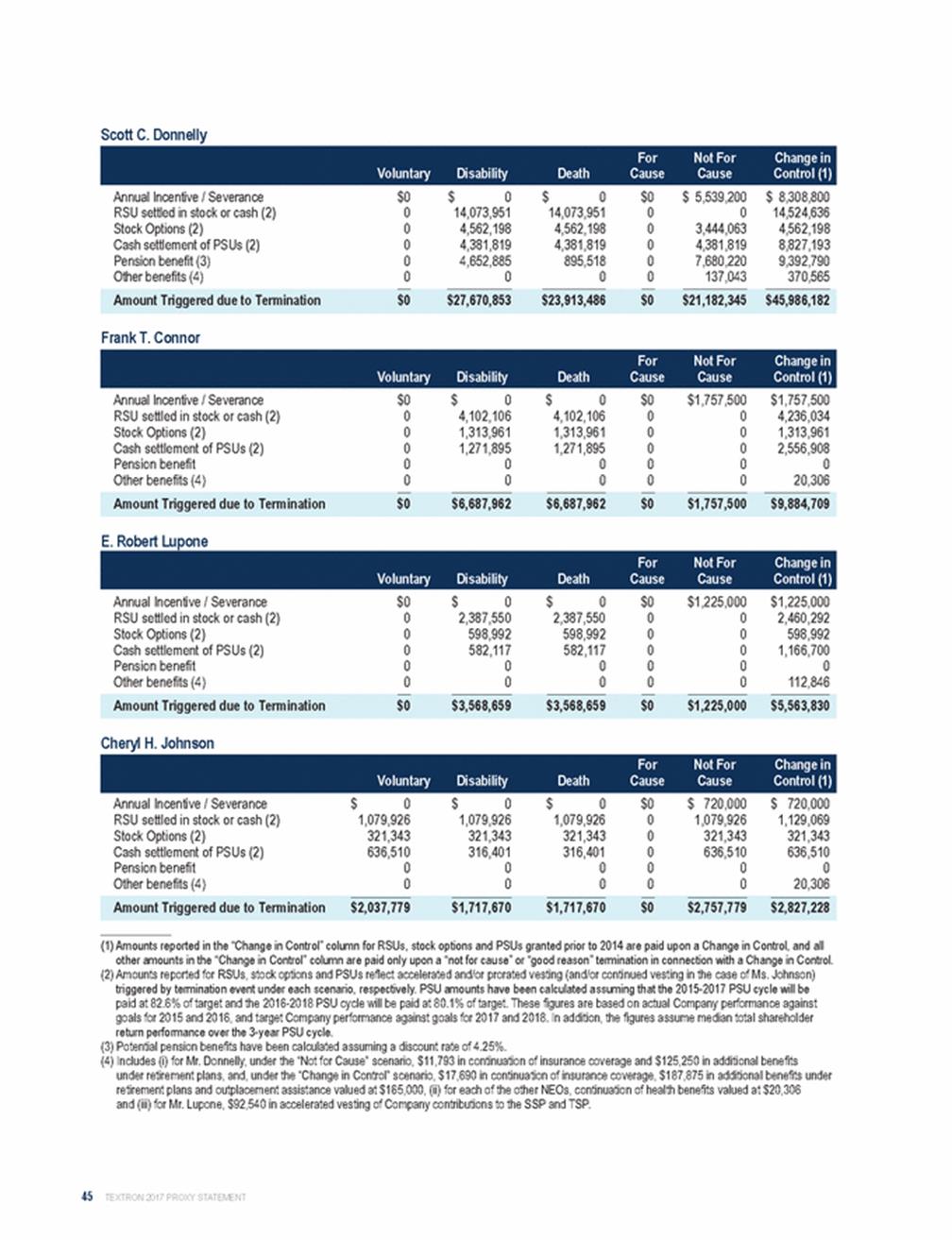Scott C. Donnelly Voluntary Disability Death For Cause Not For Cause Change in Control (1) Amount Triggered due to Termination $0 $27,670,853 $23,913,486 $0 $21,182,345 $45,986,182 Frank T. Connor Voluntary Disability Death For Cause Not For Cause Change in Control (1) Annual Incentive / Severance RSU settled in stock or cash (2) Stock Options (2) Cash settlement of PSUs (2) Pension benefit (3) Other benefits (4) 10 $ 0 $ 0 $0 0 14,073,951 14,073,951 0 0 4,562,198 4,562,198 0 0 4,381,819 4,381,819 0 0 4,652,885 895,518 0 0 0 0 0 5,539,200 $ 8,308,800 0 14,524,636 3,444,063 4,562,198 4,381,819 8,827,193 7,680,220 9,392,790 137,043 370,565 Annual Incentive / Severance RSU settled in stock or cash (2) Stock Options (2) Cash settlement of PSUs (2) Pension benefit Other benefits (4) ;o $ 0 $ 0 $0 0 4,102,106 4,102,106 0 0 1,313,961 1,313,961 0 0 1,271,895 1,271,895 0 0 0 0 0 0 0 0 0 $1,757,500 $1,757,500 0 4,236,034 0 1,313,961 0 2,556,908 0 0 0 20,306 Amount Triggered due to Termination $0 $6,687,962 $6,687,962 $0 $1,757,500 $9,884,709 E. Robert Lupone Voluntary Disability Death For Cause Not For Cause Change in Control (1) Annual Incentive / Severance RSU settled in stock or cash (2) Stock Options (2) Cash settlement of PSUs (2) Pension benefit Other benefits (4) O $ 0 $ 0 $0 $1,225,000 0 2,387,550 2,387,550 0 0 0 598,992 598,992 0 0 0 582,117 582,117 0 0 0 0 0 0 0 0 0 0 0 0 $1,225,000 2,460,292 598,992 1,166,700 0 112,846 Amount Triggered due to Termination $0 $3,568,659 $3,568,659 $0 $1,225,000 $5,563,830 Cheryl H. Johnson Voluntary Disability Death For Cause Not For Cause Change in Control (1) $ 720,000 $ 720,000 1,079,926 1,129,069 321,343 321,343 636,510 636,510 0 0 0 20,306 $1,717,670 $1,717,670 $0 $2,757,779 $2,827,228 $ 0 $ 0 $ 0 $0 1,079,926 1,079,926 1,079,926 0 321,343 321,343 321,343 0 636,510 316,401 316,401 0 0 0 0 0 0 0 0 0 Annual Incentive / Severance RSU settled in stock or cash (2) Stock Options (2) Cash settlement of PSUs (2) Pension benefit Other benefits (4) Amount Triggered due to Termination $2,037,779 (1) Amounts reported in the “Change in Control” column for RSUs, stock options and PSUs granted prior to 2014 are paid upon a Change in Control, and all other amounts in the “Change in Control” column are paid only upon a “not for cause” or “good reason” termination in connection with a Change in Control (2) Amounts reported for RSUs, stock options and PSUs reflect accelerated and/or prorated vesting (and/or continued vesting in the case of Ms. Johnson) triggered by termination event under each scenario, respectively. PSU amounts have been calculated assuming that the 2015-2017 PSU cycle will be paid at 82.6% of target and the 2016-2018 PSU cycle will be paid at 80.1% of target. These figures are based on actual Company performance against goals for 2015 and 2016, and target Company performance against goals for 2017 and 2018. In addition, the figures assume median total shareholder return performance over the 3-year PSU cycle. (3) Potential pension benefits have been calculated assuming a discount rate of 4.25%. (4) Includes (i) for Mr. Donnelly, under the "Not for Cause" scenario, $11,793 in continuation of insurance coverage and $125,250 in additional benefits under retirement plans, and, under the "Change in Control" scenario, $17,690 in continuation of insurance coverage, $187,875 in additional benefits under retirement plans and outplacement assistance valued at $165,000, (ii) for each of the other NEOs, continuation of health benefits valued at $20,306 and (iii) for Mr. Lupone, $92,540 in accelerated vesting of Company contributions to the SSP and TSP 45 TEXTRON 2017 PROXY STATEMENT
